
 GCNEWS
GCNEWS
A Newsletter for Galactic Center Research
This Volume was edited by Sera Markoff, Loránt Sjouwerman, Joseph Lazio, Cornelia Lang, Rainer Schödel & Robin Herrnstein
email: gcnews@aoc.nrao.edu

 GCNEWS
GCNEWS


P. Ubertini
(on behalf of the IBIS Team and ISWT)
Instituto di Astrofisica Spaziale e Fisica Cosmica, Roma, Italy
In the last GCNEWS issue, S. Doeleman & G. Bower nicely illustrated that the increasing capability of Very Long Baseline Interferometry (VLBI) will soon allow images to be taken very close to the region at which photons can no longer escape from the super massive black hole (SMBH), Sgr A*. We have clearly come a long way in our search to understand this object. As early as the 1960s, it was suggested that the central core of our Galaxy was a central hot engine, from the view point of energy release. This scenario became clear from the first X-ray all sky maps. Figure 1 (left) shows the 1968 X-ray sky, obtained with a number of short rocket flights, and clearly demonstrates the clustering of discovered sources toward the plane and the central region of the Galaxy.
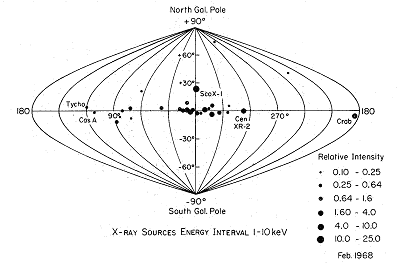
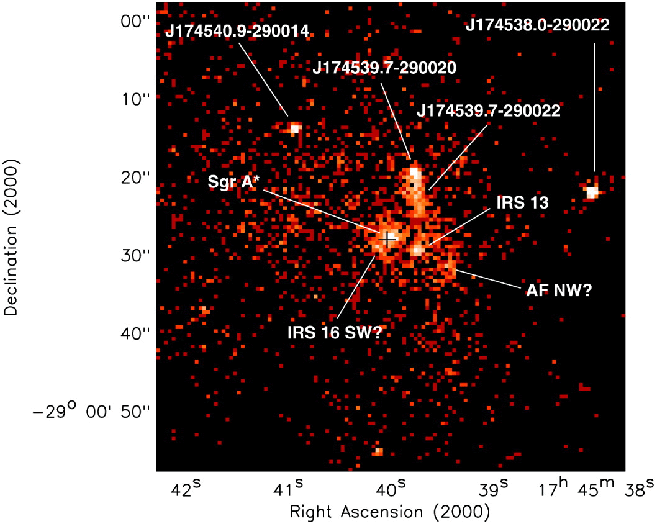
The extreme variability in time of the handful of X-ray sources discovered at that time and the ratio of the luminosity LX/Loptical of 1000 was immediately interpreted to be a powerful new observational tool. A clue to determining the dimension of the high energy emitting regions is achieved by measuring the time scale of fast transient events that were associated with physical processes showing matter accreting into a extremely high gravitational field, i.e. close to the Schwarzschild radius of the black hole or in the vicinity of the hard surface of a neutron star.
The astonishing X-ray and gamma-ray skies were depicted by a number of balloon and rocket payloads launched in the 1960s. The first X-ray satellite, UHURU, launched in late 1970, discovered more than 300 X-ray sources. Furthermore, diffuse gamma-ray emission from the plane and the central part of the Galaxy was detected by SAS 2 (NASA) and COS-B (ESA), launched during November 1972 and August 1975 respectively. COS-B also revealed high energy emission from a number of pulsars in the MeV domain.
The presence of strong, variable emission from the dynamical centre of the Galaxy, together with the diffuse emission discovered in gamma-rays were consi dered the major clues for the existence of a massive-peculiar object located there, as predicted by Lynden Bell and Rees in 1971. The discovery by Balick and Brown (1974; also see GCNEWS Vol. 18) of a sub-arcsec compact radio source three years later was the proof of the peculiarity of the GC. Since then, the poor angular resolution of X-ray and gamma-ray telescopes has hampered the unambiguous detection of high energy emission from Sgr A* for almost 30 years. A detection of short time variability at high energies from the central degree of the Galaxy had been identified with early high energy satellites (in the 1970s), however it has been difficult to assign this variability to Sgr A* itself.
The quest for a high energy sign of vitality was continued using a coded mask experiment on board Spacelab 2 (1985), sensitive in the hard X-ray range (2.5-30 keV), with the detection of a source 1 arcmin from the centre (Skinner et al. 1987): the result was puzzling because it was clearly not radiation coming from Sgr A* but rather one of the active binaries in the crowded Galactic Centre region. At even higher energy none of the satellites of the 1990s had the sufficient angular resolution and sensitivity to be able to understand the lack of gamma-ray emission from this region. In fact, the OSSE experiment on board the Compton Gamma Ray Observatory provided high sensitivity, but was not able to do imaging studies. SIGMA, the French-Russian high energy imager on board the GRANAT satellite, in spite of the 15 arcminute imaging capability above 35 keV, did not have the required sensitivity to image the Sgr A* region. SIGMA spent as much as 9 million seconds on the GC in the time frame 1990-1997 and derived only an upper limit for gamma-ray emission from the SMBH vicinity (Goldwurm et al. 1994, Goldoni et al. 1999).
Finally, the first X-ray detection from the compact radio source region was achieved by the Chandra X-Ray Observatory in 1999 (Baganoff et al. 2003; Figure 1 (right)) followed by the detection of short flaring activity demonstrating the high energy emitting region was extremely close to the SMBH (Goldwurm et al., 2003). Similarly, Sgr A* was recently discovered to flare frequently in the near-IR (Genzel et al. 2003; Ghez et al. 2004). This implies that both the near-IR and X-ray emission arise from a region of only 10-15 light minutes across, i.e. the dimension of our solar system. At high energies, the lack of the expected strong, variable emission from SgrA* has always been mysterious: stellar mass black holes (Cygnus X-1 is the prototype) or the central BH in active galactic nuclei (AGN) typically show high luminosity and strong gamma-ray emission, mainly due to Comptonisation of low energy photons (0.2-1 keV) up-scattered by the high energy electrons of the hot plasma surrounding the collapsed object. So, why is Sgr A* extremely sub-luminous even with the expected accretion rate of the order of few 10-6 Mo yr-1 (Melia & Falke, 2001)?

INTEGRAL is an astrophysical gamma-ray observatory with unprecedented sensitivity and angular resolution that was launched from Baikonour (Kazakhstan) in 2002 October (Figure 2). INTEGRAL is devoted to observing the gamma-ray universe in the energy range from 15 keV to 10 MeV with substantial monitoring capability in the X-ray range (3 to 30 keV) and also in the optical V-band at 550 nm (Winkler 2003). It is an international mission led by ESA with main payload contribution from Italy, France and Germany, several other European countries, and the USA.
The two gamma-ray instruments are the spectrometer (SPI) and the imager (IBIS). SPI is a high resolution, cooled germanium based coded mask spectrometer with unprecedented sensitivity to diffuse emission over a very wide field of view ( 25o FWHM) and optimized for the high resolution gamma-ray line spectroscopy in the energy range 20 keV--8 MeV (Vedrenne et al. 2003). IBIS (Ubertini et al. 2003) is a large-area, coded aperture mask telescope based on two layers of 16,384 Cadmium Telluride detectors (Lebrun et al. 2003) and 4,096 Caesium Iodide detectors (Labanti et al. 2003). This configuration provides angular resolution of 12 arcmin, with wide spectral response (15 keV to 10 MeV) and high resolution timing (60 s) and spectroscopy (6% at 100 keV). In view of the impossibility of focusing high energy X-rays and soft gamma-rays, the three high energy instruments are operated with a coded mask device to provide good imaging capability over a wide field of view. The coded mask technology and pixel size are different for the X-ray monitor and for the two gamma-ray instruments. The coded mask technique allows one to obtain a large sky image (of the order of 1000 squared degree) coupled with high spatial resolution, which will independently provide the position, spectra and light curve of each gamma-ray source detected.
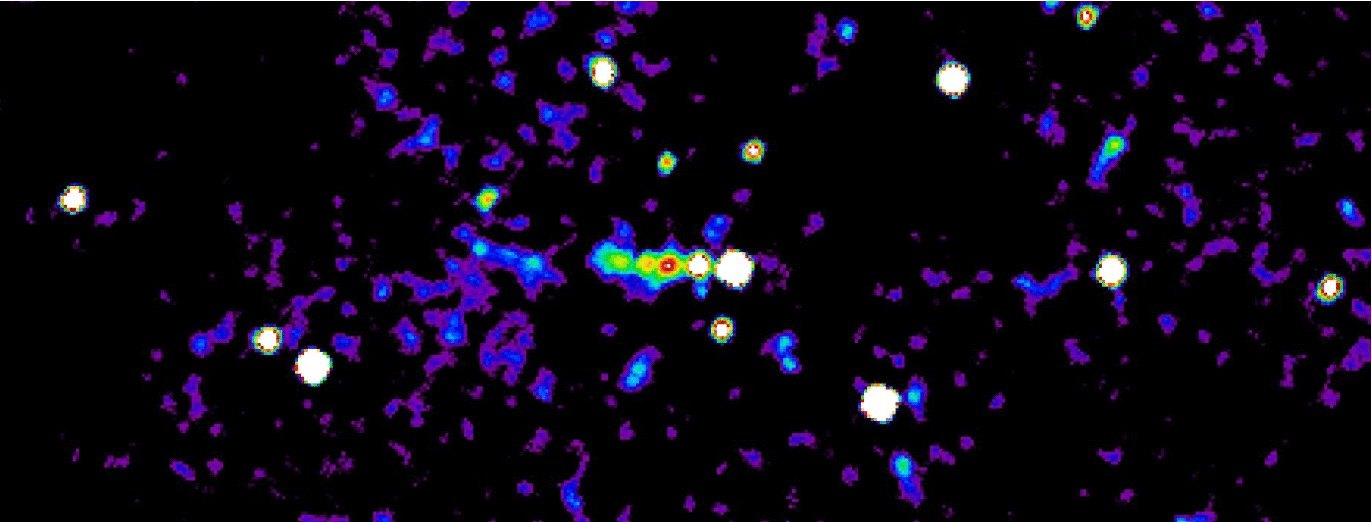
INTEGRAL, compared with earlier high energy observatories, such as BeppoSAX, RXTE, GRANAT or the COMPTON observatories, features almost an order of magnitude improved performances in spectroscopy and imaging (Winkler 2003). IBIS can achieve simultaneously an unprecedented sensitivity, 10 times better than SIGMA, with 12 arcmin angular resolution and a 1000 squared degree field of view: all the gamma-ray sources active in the pointed region with a flux exceeding a milliCrab (3*10-11 erg/cm2s) can be located with an accuracy of the order of one arcmin in a day (Figure 3).
At the end of February 2003, INTEGRAL started one of its key programmes planned to guarantee high scientific return for the mission and the hardware teams. This programme was entitled The Galactic Centre Deep Exposure and involved observations of this region carried out for about 2.5 Ms, deeply imaging the Sgr A* region for more than 1.1 Ms. After 30 years of unsuccessful attempts to detect high energy emission from the nuclear region of our Galaxy, IBIS has detected gamma-rays from 6 known high energy sources plus a new one (IGR J1745.6-2901) which coincides with the radio position of Sgr A* to within 0.9 arcmin.
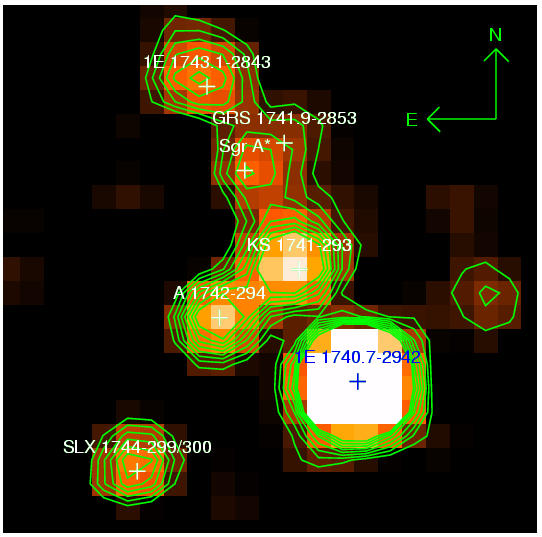
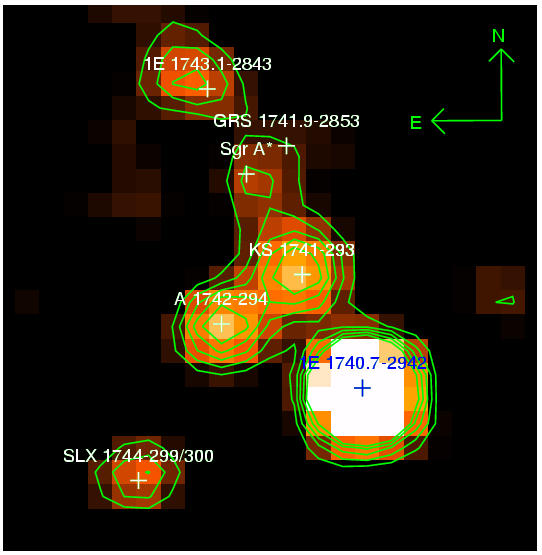
Figure 4 shows the 2*2 square degrees image of the Galactic Centre constructed by adding 600 independent IBIS/ISGRI pointings. The two images show integrated energies over the range of (a; left) 20-40 keV and (b; right) 40-100 keV, illustrating for the first time the details of this region with a sensitivity threshold of the order of a milliCrab. The more luminous of the detected source is a black hole candidate (BHC) 1E1740.7-2942, also known to be a galactic microquasar, due to its superluminal plasmoid emission (Mirabel et al. 1992). Three of the other gamma-ray sources are known, weakly-magnetised neutron stars, A1742-294, KS1741-293 and SLX1744-299. They are all part of low mass X-ray binary systems (LMXB) emitting X-ray bursts lasting from ten to few hundred seconds. These bursts have been discovered to be thermonuclear flashes of hydrogen and helium as the result of matter accreted from the low mass, non-evolved companion on the hard crust of the NS surface and have spectral emission extended up to several tens of keV. When the temperature and pressure reach the ignition values, the short flash occurs (Lewin et al. 1993) transforming the gravitational energy in X-rays and gamma-rays. SLX1744-300 is another LMXB, separated 3 arcmin from SLX1744-299. The sixth gamma-ray source is 1E1743.1-2843, whose nature is still unknown.
In the map of energy in the 20-40 keV range, a source ( 9 sigma excess) is detected in the vicinity of Sgr A*, coinncident with the radio source. The newly detected source (IGR J1745.6-2901) shows some elongation in the north-west direction, which is considered to be a contribution from the known BHC GRS 1741.9-2853. At higher energies (40-100 keV) the Sgr A* flux is weaker and is detected at 5 sigma, but, as expected, the contribution from the nearby BHC source is decreasing. The total flux integrated over the entire energy range is about 3.8*10-11 erg/cm2s, i.e. corresponding to a few times 10-3 the flux of the Crab. This value clearly confirms the under-luminous behaviour of the SMBH thought to be associated with Sgr A*. This also confirms the peculiar behaviour of our nucleus, when compared with stellar-mass binary BHCs or SMBHs in extragalactic AGNs.
New models to explain, at least in a first approximation, the X-ray and gamma-ray behaviour of the non-efficient accretion of the GC (Melia & Falcke 2001) may now need to be refined in view of the INTEGRAL results. The details of the IBIS detection of gamma-ray radiation from Sgr A* and the Galactic Centre region are too long to be outlined here and are discussed in depth in Belanger et al. (2003). It is clear that a part or most of the detected radiation could be due to one or more of the active binary objects in the vicinity of Sgr A* in view of the limited, even if unprecedented, INTEGRAL/IBIS accuracy. In any case, the capability of IBIS to pin point the arrival direction of new gamma-ray photons and its unprecedented sensitivity have permitted for the first time to show high energy emission from the vicinity of the SMBH or, perhaps from the inner part of its accretion disk. After a 30 year quest, the time variability of Sgr A* could be again a clue to demonstrate the origin of high energy radiation. In fact, the strong near-IR flares observed by Genzel et al. in May 2003 may be coming from a region close to the Sgr A* event horizon. This seems to be a direct signature of radiation coming from the SMBH, which may give us a chance to observe simultaneous X-ray and gamma-ray fast variability in a planned XMM and INTEGRAL coordinated observation. In the future, the new generation of X-ray and gamma-ray instruments and observatories will only improve our understanding of the region near Sgr A*.